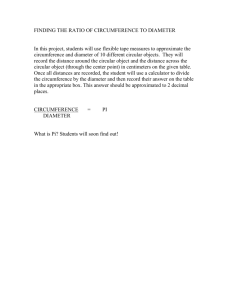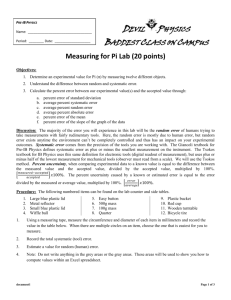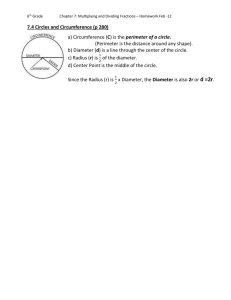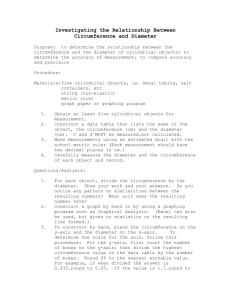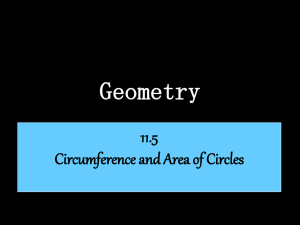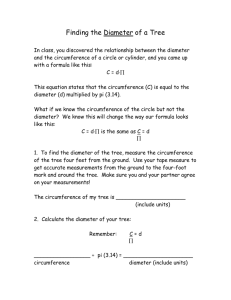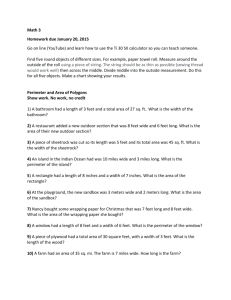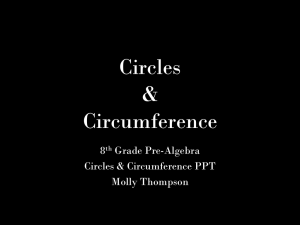Circle Lab #1 - Teacher Pages
advertisement
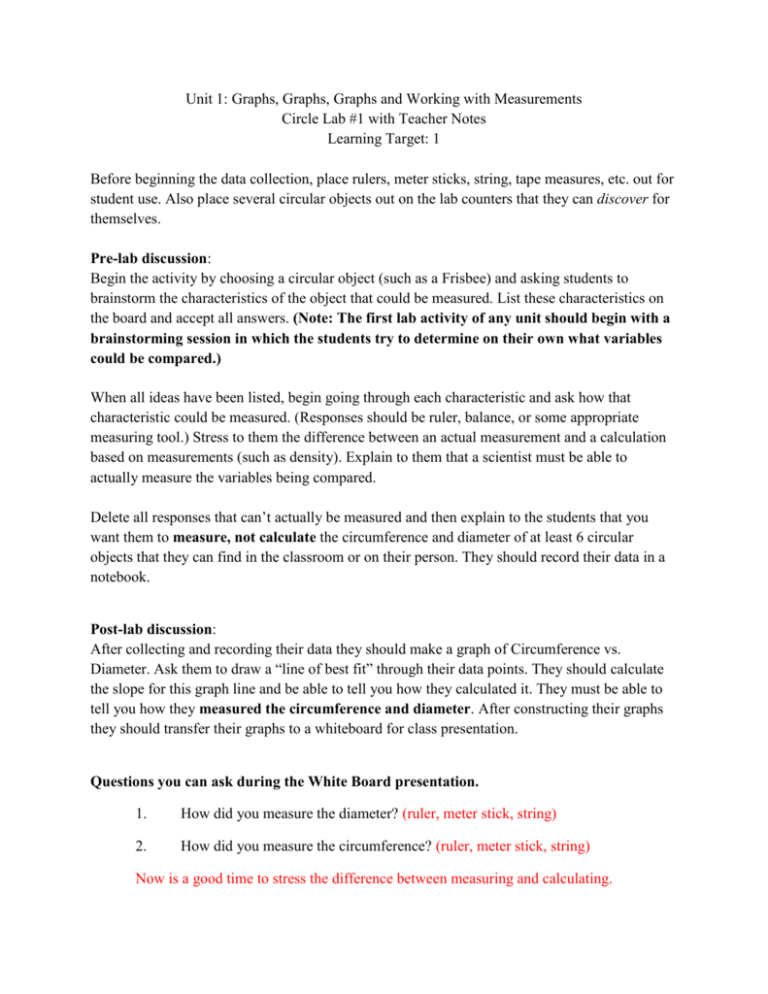
Unit 1: Graphs, Graphs, Graphs and Working with Measurements Circle Lab #1 with Teacher Notes Learning Target: 1 Before beginning the data collection, place rulers, meter sticks, string, tape measures, etc. out for student use. Also place several circular objects out on the lab counters that they can discover for themselves. Pre-lab discussion: Begin the activity by choosing a circular object (such as a Frisbee) and asking students to brainstorm the characteristics of the object that could be measured. List these characteristics on the board and accept all answers. (Note: The first lab activity of any unit should begin with a brainstorming session in which the students try to determine on their own what variables could be compared.) When all ideas have been listed, begin going through each characteristic and ask how that characteristic could be measured. (Responses should be ruler, balance, or some appropriate measuring tool.) Stress to them the difference between an actual measurement and a calculation based on measurements (such as density). Explain to them that a scientist must be able to actually measure the variables being compared. Delete all responses that can’t actually be measured and then explain to the students that you want them to measure, not calculate the circumference and diameter of at least 6 circular objects that they can find in the classroom or on their person. They should record their data in a notebook. Post-lab discussion: After collecting and recording their data they should make a graph of Circumference vs. Diameter. Ask them to draw a “line of best fit” through their data points. They should calculate the slope for this graph line and be able to tell you how they calculated it. They must be able to tell you how they measured the circumference and diameter. After constructing their graphs they should transfer their graphs to a whiteboard for class presentation. Questions you can ask during the White Board presentation. 1. How did you measure the diameter? (ruler, meter stick, string) 2. How did you measure the circumference? (ruler, meter stick, string) Now is a good time to stress the difference between measuring and calculating. 3. What is the independent variable being studied? What do we mean by independent variable? Where is it placed on the graph? Diameter; the variable being controlled by the experimenter; placed on the x-axis 4. What is the dependent variable being studied? What do we mean by dependent variable? Where is it placed on the graph? Circumference; the variable that responds to the independent variable; placed on the yaxis. 5. What does this graph tell you about the relationship between the circumference and diameter of a circle? As the diameter increases the circumference also increases. They are directly related. This is a linear relationship. It is a direct proportion as the graph begins at the origin. 6. What is the shape of this graph? Linear; a direct relationship 7. Draw a line of best fit for this graph. Expect to see anything here. Some will draw a correct line of best fit, others will insist that it must go through the origin and connect dot-to-dot and not have a y-intercept. This is a good time to discuss “line of best fit”. Stress why we don’t connect dot-to-dot on any scientific graph. 8. What do we mean by “line of best fit?” A line drawn through the data points that is on or near most of the data points; it does not necessarily begin at the origin; only begins at the origin if it is in line with all other data points and is a valid point. Lines of best fit do not connect dot-to-dot. 9. Is (0,0) a valid data point for this graph? Why or why not? Yes; if a circle has no diameter then it can have no circumference. 10. Must the line of best fit begin at 0,0? No; only if (0,0) is in line with all other data points. 11. How did you calculate the slope of this graph? y2 – y1/x2 – x1; or the change in y divided by the change in x; Δy/Δx; Stress to them that slopes are calculated by taking two points off the line of best fit and not taking two actual data points unless they lie on the line of best fit. Calculating slopes from the line of best fit insures a more accurate value based on the average of ALL the data. 12. What does the slope of this graph mean or tell you? Tells us the numeric relationship between circumference and diameter for any circular object. Should be close to π; some will recognize this; if they don’t, don’t sweat it. Circumference ≈ 3.14 (diameter); don’t expect 3.14 for all slopes; most will get close to this; only those that calculated circumference will actually get 3.14. Those that measured circumference will get close to 3.14; more like 3.1 to 3.3 13. What is the unit for the slope on this graph? No unit; units will cancel if they measured in the same unit; Stress here that not all slopes have units. If the variables have different units of measure then the slope will have a unit; Examples: g/cm3 14. What is the general equation for this graph? y = mx + b 15. What does “m” represent in this equation? Slope 16. What does “b” represent in this equation? y-intercept 17. What is the specific equation (mathematical expression) that fits only this graph? Circumference (cm) =3.2 (Diameter(cm) Discuss with them the actual mathematical analysis for their specific graph and tell them this analysis represents ONLY their graph and no other linear graph. Mathematical Analysis: Always includes 4 steps y = mx + b (general equation for the graph) m = 3.2 (slope value) y = 3.2x + b (general equation with slope value included) Circumference (cm) =3.2 (Diameter(cm) if b = 0 (specific equation with all variables named and slope value and y-intercept given if there is a y-intercept) This equation is called the Mathematical Model Equation Discuss the 5% rule with them; if the y-intercept is 5% or less than their maximum y value then it is negligible and does not need to be included in their mathematical model equation. You will need to explain to them what “negligible” means and explain how to calculate the y-intercept percentage. They won’t know how to do this. 5% calculation: (y-intercept/maximum y value) x 100% Any other questions that you can think of to ask will help them clarify all of the above. As you discuss with them, you’ll think of all kinds of things to ask or point out. Remember: Assume that they know nothing. Most of them have learned plenty of facts and have applied very little of what they know.
